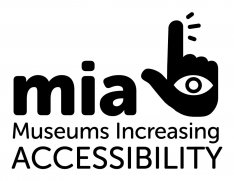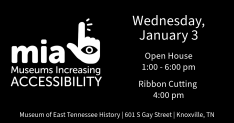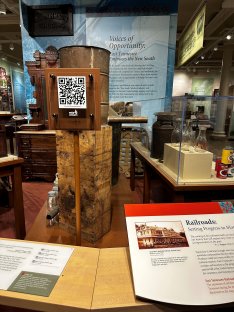
|
Second Floor Hours
865-215-8824, eths@eastTNhistory.org |
First Floor Hours
865-215-8830 |
Third Floor Hours
865-215-8801 |
Second Floor Hours
865-215-8800 |

Unveiling of MIA, a new accessibility feature for the visually impaired
The East Tennessee History Center is launching a new accessibility program that aids individuals with visual impairments in touring the Museum of East Tennessee History and navigating the various floors of the History Center.
The impetus for this new project was Girl Scout Mia Warren, who brought her Gold Award project to East Tennessee Historical Society and Knox County Public Library team members to develop a comprehensive gallery tour for visually impaired guests using interpretive text and written descriptions of key objects. Mia was inspired to pursue this as her Gold Award project after visiting museums with her friend Campbell Rutherford, who is visually impaired. “It would be nice not to rely completely on someone else, so if I wanted to stay back and finish looking at an exhibit, while someone else went on ahead, I could have that freedom,” remarked Campbell.
Approximately 20 million Americans (or 8% of the US population) have some degree of visual impairment. Museums across the country offer varying degrees of access for visually impaired guests, from Braille handouts to audio tours.
Campbell recommended an innovative method that allows visually impaired visitors to utilize screen readers on their personal devices. Instead of being asked to carry an audio stick, download a separate application, or use other unfamiliar technology, the MIA system allows guests to scan QR codes placed strategically throughout the History Center. These codes open webpages that contain a comprehensive written description of the space. Specially optimized for screen readers, the guest’s device then reads the description to the guest, providing them cues on how to safely navigate the space and in-depth descriptions of what is displayed that space. The webpages may also be used by guests with restricted eyesight, who may choose to adjust the font size and contrast of the text, or by deaf-blind guests, who may access the same content via a portable Braille reader.
“It’s all about thinking of others,” said Mia. “We can help a lot of people who just want to get the full experience out of a museum.”
The East Tennessee History Center is grateful for to Mia and Campbell for helping move this new accessibility initiative from discussion to action. The History Center is also indebted to Mia for the countless hours she expended in organizing the museum’s interpretive text, measuring distances between displays, and writing descriptions of objects.
MIA: Museums Increasing Accessibility is a project of the Museum of East Tennessee History and is an on-going initiative to increase accessibility in the museum for all.











